公开课教案earthquake
防震减灾公开课教案10篇
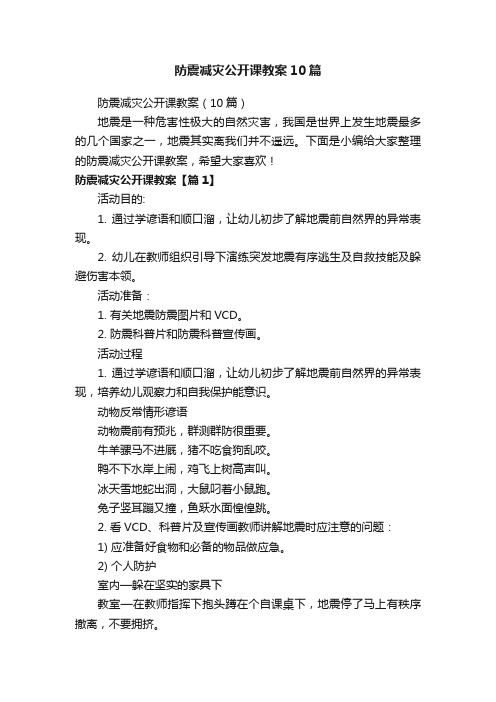
防震减灾公开课教案10篇防震减灾公开课教案(10篇)地震是一种危害性极大的自然灾害,我国是世界上发生地震最多的几个国家之一,地震其实离我们并不遥远。
下面是小编给大家整理的防震减灾公开课教案,希望大家喜欢!防震减灾公开课教案【篇1】活动目的:1. 通过学谚语和顺口溜,让幼儿初步了解地震前自然界的异常表现。
2. 幼儿在教师组织引导下演练突发地震有序逃生及自救技能及躲避伤害本领。
活动准备:1. 有关地震防震图片和VCD。
2. 防震科普片和防震科普宣传画。
活动过程1. 通过学谚语和顺口溜,让幼儿初步了解地震前自然界的异常表现,培养幼儿观察力和自我保护能意识。
动物反常情形谚语动物震前有预兆,群测群防很重要。
牛羊骡马不进厩,猪不吃食狗乱咬。
鸭不下水岸上闹,鸡飞上树高声叫。
冰天雪地蛇出洞,大鼠叼着小鼠跑。
兔子竖耳蹦又撞,鱼跃水面惶惶跳。
2. 看VCD、科普片及宣传画教师讲解地震时应注意的问题:1) 应准备好食物和必备的物品做应急。
2) 个人防护室内—躲在坚实的家具下教室—在教师指挥下抱头蹲在个自课桌下,地震停了马上有秩序撤离,不要拥挤。
室外—远离狭窄街道、高大建筑等。
3. 以游戏形势进行简单防震演练。
小结通过谚语、图片、游戏等方式使幼儿基本掌握地震突发事件时逃生和自救技能,让幼儿掌握来不及逃离情况下如何躲避地震伤害的本领,达到教学目的,效果很好。
延伸把今天学到的知识讲给家人听,或者考一考他们防震知识。
防震减灾公开课教案【篇2】活动目标:1、通过演习,训练教师和幼儿在地震的状况下根据幼儿园的环境有序地通过安全疏散通道。
2、教育幼儿遇到地震时能听从老师和成人的指挥,做出基本的自救行为。
3、培养幼儿防震减灾的安全意识和自我保护能力。
4、考验小朋友们的反应能力,锻炼他们的个人能力。
5、体验模仿游戏的快乐。
活动准备:1、录像和图片2、了解地震中自救的基本常识。
活动过程:一、感受地震给人类带来的灾难.1、讲述地震来临时的情况。
Unit4_Earthquake 教案(新人教版必修1)
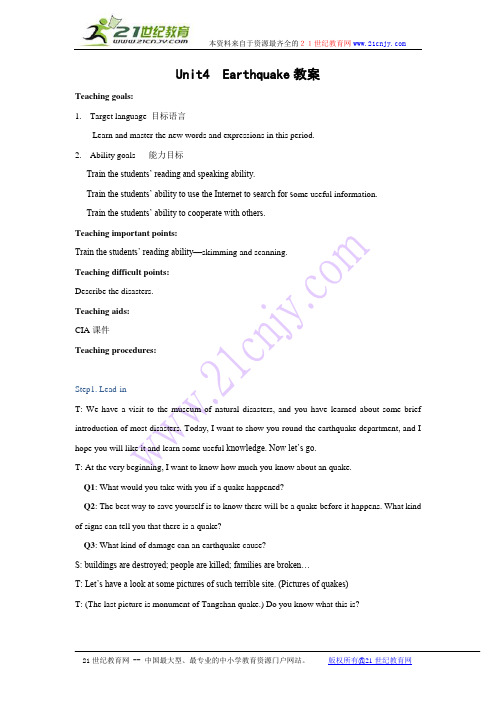
Unit4 Earthquake教案Teaching goals:1.Target language 目标语言Learn and master the new words and expressions in this period.2.Ability goals 能力目标Train the students’ reading and speaking ability.Train the students’ ability to use the Internet to search for s ome useful information.Train the students’ ability to cooperate with others.Teaching important points:Train the students’ reading ability—skimming and scanning.Teaching difficult points:Describe the disasters.Teaching aids:CIA课件Teaching procedures:Step1. Lead-inT: We have a visit to the museum of natural disasters, and you have learned about some brief introduction of most disasters. Today, I want to show you round the earthquake department, and I hope you will like it and learn some useful knowledge. Now let’s go.T: At the very beginning, I want to know how much you know about an quake.Q1: What would you take with you if a quake happened?Q2: The best way to save yourself is to know there will be a quake before it happens. What kind of signs can tell you that there is a quake?Q3: What kind of damage can an earthquake cause?S: buildings are destroyed; people are killed; families are broken…T: Let’s have a look at some pictures of such terrible site. (Pictures of quakes)T: (The last picture is monument of Tangshan quake.) Do you know what this is?Step2. Pre-ReadingT: 30 years ago, on the day July, the 28th, a terrible disaster suddenly happened, and the beautiful Tangshan was removed from the map. This is Tangshan quake. Does any body know something about Tangshan quake?T: Let’s read a news report about the famous quake.Step3. While-readingI. Skimming & scaringGet the students comprehend the passage quickly and accurately, and meanwhile help the students to form a good habit of reading.T: First please skim the passage fast to obtain/ get a general understanding of the whole passage. And underline the answers to the following questions.1.When did the quake happen? (Why did the writer use different expression of the samething?)2.How many people were killed and injured during the quake?3.How many buildings were destroyed?II. While reading, divide the whole passage into 3parts and find out the main idea of each part. Para.1 before the quakePara.2-3 during the quakePara.4 after the quakeII. Careful-readingRead the passage again and try to get more detailed information.T: Now let’s read the passage again and find more information. Join the correct parts of the sentences. (Turn to page 27, ex1)T: Now you have read the passage carefully, please put the sentences in order. Number each of these things during the Tangshan quake.(Turn to page 27, ex2)T: here are some more work for you. You can work in groups.1.What strange things happened before the quake?2.What sentences can express the quake is GREAT?3.What numbers can express the quake is GREAT?4.What metaphor does the writer use to say the quake is GREAT?5.What happened when rescue work was going on?6.How did the army help to rescue survivors?T: Let’s watch some pictures, and comparing the old Tangshan, the Tangshan after quake, and the new Tang Shan we see today.Step 4 Post-reading (discussing)T: After read the news report, and see so many pictures, what impresses you most? Why?Or what do you learn from such a disaster?(Self-rescue, environment protection, rebuilt, love and help)I: self-rescue (a video game)T: When in a quake, if you know some self-rescue skills, you may probably save yourself. If you want to know some of the skills, click here. (Link to the index)Let’s do little game to see how much you know about self-rescue.II. What did they suffer and feel?T: Can you understand what they suffer and what they feel after such a disaster?T: If you were one of the rescuers 30 years ago, what could you say and what can you do to comfort them? Or how could you help them?III. RebuildingT: we see that the new Tangshan has been set up. What is needed to rebuild Tangshan.IV: environment protectionT: nowadays there are more disasters than before. One of the reasons is that we pay more attention to our economy development than the earth we live.Look at these pictures. What can we students do to save the earth?T: Though the disasters destroy buildings, people’s lives, but it can n ot destroy the love among us.Step 5 Homework1.Find more news reports about earthquake.2.Write a piece of news about Tangshan. You can use the information in the passage.Warming up by discussingNow, look at the pictures of Tangshan and San Francisco in warming up and describewhat you see in the pictures. (beautiful cities; broad roads; tall building; large population.)What will happen if there has been a big earthquake in these two cities?As we all know, earthquakes are disasters to everyone. But can we avoid or at least reduce the loss caused by earthquakes? Can we foretell earthquakes? Now let’s come to Pre-reading and decide what may happen before an earthquake comes.II. Pre-reading1.Talking and sharingWhat are the signs of an earthquake? (e.g. Cows, pigs and dogs become too nervous too eat. The mice will run out of the fields looking for places to hide. The water in the wells will rise and fall. Walls of the wells in village will have deep cracks. There will be bright light in the sky….)2. Imaging and sharingImagine there is an earthquake now, your home begins to shake and you must leave it right away. You have time to take only one thing. What will you take? Why?III. Reading1. Listening and fast readingNow let’s come to the text “A NIGHT THE EARTH DIDN’T SLEEP” and see what it tells us. Please listen to the text and get the general idea of the passage. You should pay attention to the first sentences of each paragraph. In what order is the text written? (The text is written in time order. The general idea is the mixture of the first sentences of each paragraph, that is, the text tells us something that happened before the earthquake, during the earthquake and after the earthquake.)2. Reading and underliningNext you are to read and underline all the useful expressions or collocations in the passage. Copy them in your notebook after class as homework.Collocations from A NIGHT THE EARTH DIDN’T SLEEPa smelly gas, come out of, in the farmyards, too nervous to eat, run out of, lookfor place to hide, water pipes, think little of sth., as usual, it seemed that, at anend, one hundred kilometers away, one-third, eight kilometers long, thirty meters wide, cut across, in ruins, be injury, the number of, reach more than 400, 000, everywhere, everything was destroyed, be gone, blow away, sth. be not safe for, thousands of, give milk, half a million, instead of, be shocked, later that afternoon,be trapped under the ruins, fall down, all…is/was not…,hundreds of thousands of,dig out, the dead, to the north of, coal mines, built shelters, fresh water3. Reading aloud and translatingNext we are going to read aloud the text and translate it into Chinese.4. Reading and transforming informationRead the text again and answer the following questions.1. What natural signs of coming disaster were there?2. Can you think of some reasons why these signs weren’t noticed?3. Can you describe the disaster caused by the earthquake?4. What events and situations probably made the disaster worse?5. How were the survivors helped?6. Could anything more have been done to help the survivors? Why or why not? Answers: 1, 3, 4, 5 are easy to answer.2. Maybe at that time people didn’t have knowledge of an earthquake.6. The students have their own answers.4. Discussing writing styleAs you have understood the general idea of the text, I still put more questions to you.1.From whose point of view are events described? How do you know? (A writer who didn’t see the quake uses the third person “they” when he wri tes.)2.Why do you think the writer chose to express her feelings about the quake rather than simply report what happened? (Although the writer was not there he felt sad for the people of Tang Shan. He knows that giving some feelings will make the reading more interesting.)3.Why is the title “A NIGHT THE EARTH D I DN’T SLEEP”? (As usual, night is thetime to sleep, and night should be quiet and safe. But that night everything changed. The writer used it as a title to show how terrible and how unusual that night is.)5. Reading and understanding difficult sentences.If you have some difficult sentences to understand, come to me for help.IV. Closing downClosing down by doing exercisesNow please do the comprehending Exercises 1, 2 and 3 on page 27.Closing down by discussingBy now you’ve known that earthquakes are terrible natural disasters and that China is unlucky enough to have a lot of them. Now imagine that your group lives in the city that has a lot of earthquakes, what should you do during an earthquake? Look at the given situation and discuss in pairs.(1) If you are OUTDOORS, …(2) If you are in a HIGH BUILDING, …(3) If you are DRIVING, …(4) If you are HAVING CLASS, …(5) If you are in a CINEMA, …What should you do during the earthquake?Situation:(1) how to rescue those still trapped in the ruins;(2) how to take care of the survivors;(3) how to repair buildings that survived the earthquake;(4) what to do with the buildings that survived the earthquake;(5) where to find people to help build a new city;(6) how to teach children about earthquake safety;(7) where to put information for survivors and their families;(8) how to plan for further disasters.Period 2: A sample lesson plan for Learning about Language(The Attributive Clause: that, which, who, whose)AimsTo learn about the usage of who, which, that and whose in the Attributive ClauseTo discover useful words and expressionsProceduresI. Warming upWarming up by discovering useful words and expressionsHello everyone. After reading the passage, we have got to know the usage of the words and expressions, but we should do more practice. Now turn to page 27 to find the correct words and expressions from the passage to finish the sentences. You are given two minutes to finish them. Of course, you can discuss with your partners. Two minutes later, check in pairs and then check with the whole class.II. Learning about language1. Reading and findingTurn to page 26 and read the text A NIGHT THE EARTH DIDN’T SLEEP. Tick out the attributive clauses in the reading passage and translate them into Chinese.2. Doing Exercises 2 on page 28Turn to page 28 and do Exercise 2 in pairs.III. Ready used materials for Relative Pronouns: which, that, who whom whoseWhat are Relative Pronouns?Relative pronouns are special pronouns which can connect the antecedent and theattributive clause. Also they can be used as a part of the attributive clause. Here are some important differences:1.w hich/ that: referring to things, can be used as a subject or an object in the attributive clause; when they are used as an object, they can be omitted:The plane is a machine that/which can fly.The school (that/which) he visited last week is to the south of the city.2.that/ who/whom: referring to a person, can be used as subject or object in the attributive clause; whom can be used as an object:The girl (that/whom/who) we saw yesterday was Jim’s sister.The man that/who is talking to my father is my maths teacher.3. whose: referring to a person or a thing, can be used as an attribute in the attributive clause:This is the writer whose name is known all over the world.The room whose window faces south is mine.4.Before everything, anything, everybody, anybody, all, the best +n, thefifth +n, we use that instead of which:All (that) I need is time.This is the largest factory (that) I have ever visitedThe sixth lesson (that) we are learning is the most difficult in Book Two.5. We can’t use that in a Non-Defining Attributive Clause:I have lost the pen, which I like very much.I have two sisters, who are both teachers.IV. Closing down by doing a quizNow you are going to take a quiz on Relative Pronouns.Fill in the blanks, using which, that, who, whom, whose.(1) The force ( ) causes everything to fall towards the ground is called gravity.(2) A friend ( ) helps you in time of need is a friend indeed.(3) Do you know the girl ( ) parents are teachers in our school?(4)The woman ( ) I spoke to just now is my English teacher.(5) He saw a house ( ) windows were all broken.(6)Everything ( ) can be done today mustn’t be done tomorrow.(7)Can you think of anyone ( ) could look after him?(8)This is the best hotel ( ) I know.(9)The man ( ) I saw told me to come back today.(10)Those ( ) want to go to the Great Wall write down your names here.(11) He talked a lot about the teachers and the schools ( ) he had visited.(12)The ninth lesson ( ) we are learning is the most difficult in Book One.(13)Mount Blanc(勃朗峰), ( ) they visited last month, is the highest mountain in(14)We know all the teacher ( ) work in our school.(15)The house in ( ) Lu Xun once lived is a museum now.(16)The house ( ) Lu Xun once lived is a museum now.(17)The house ( ) Lu Xun once lived in is a museum now.(18)You can take any room ( ) you like.(19) He showed a machine ( ) parts are too small to be seen.(20)The sports meet was put off, ( ) was exactly what we wanted.Answers to the exercises: (1)which/that (2)who/that (3)whose (4)whom/that/who (5)w (6)that (7)that (8)that (9)that/whom/who (10)who (11)that (12)that (13)which (1 (15)which (16)in which/where (17)which/that (18)that (19)whose (20)whichPeriod 3:A sample lesson plan for Using Language(A letter from Zhang Sha)AimsTo read and speak about travelingTo write a letter describing feeling about travelingProceduresI. Warming upWarming up by discussingHave you ever written a speech? What is a speech? Speech means an act of speaking formally to a group of listeners. What do you have to consider when you are writing a speech? Please discuss it in pairs. (1. Who is the audience? 2. How can we express ourselves clearly?)Warming up by readingWhat should you include in your speech when you try to write one? Read the letter on page 29 and imagine you are the student who was invited to give a speech. Now write a short speech, in which you should follow the points in exercise 3 on page 29.II. Reading and underliningRead the letter and exercises again and underline all the useful expressions or collocations in the letter. Copy them in your notebook after class as homework.Collocations from the lettercongratulations, be pleased to do sth., win the high school speaking competition, a group of five judges, all of whom, agree, be proud of, open a new park, honour those wh died in the terrible disaster, would like to do, have you do sth., as you know, invite sb.to do sth., on that special day, at the beginning of, thank sb, for doing sth.,honour sb. for sth., be known as, encourage sb. to do sth., be happy to do sth.,collect stamps, lose one’s lifeIII. ListeningTurn on your books at page 30. We’ll listen to a story about a person who experienced the 1906 S an Francisco earthquake. I’ll play the tape three times. First listen and try to get some details that exercises 1 and 2 request. Second listen again and try to finish the exercises. Third listen and check your answers.IV. Guided writing (SB. page 31)1. Making a introductionHave you ever read a newspaper story? Now turn on your books to page 31 and look at Writing.Read the brief description about how to write a newspaper story. Compare a newspaper story to a short story and answer the following questions.1) What should you write before writing a newspaper story? (outline)2) What should a newspaper outline have? (a headline; a list of main ideas; a list of important details)3) Why a headline is needed? (It can tell the readers what the topic is; it can also attract the readers’ attention)4) How can you finish a newspaper story? (First, you should write a headline, then organize your main ideas into paragraphs, and then put some details into each paragraph.)5) Have you found out the difference between a newspaper story and a short story? (Usually a short story begins with small details and includes big details later. A newspaper story does just the opposite. Both kinds of stories use paragraphs with main ideas. In a good newspaper story, the point-of-view is objective (i.e. it has no point-of-view) while a short story is subjective (i.e. it has a point-of-view). A newspaper story has no conclusion; a short story generally does.)Now I’ll show you a newspaper story to find out the headline, main idea and details of each paragraph.THE WASHINGTON POSTSEATTLE-A powerful earthquake with a magnitude of 6.8 hit Washington State last week. The quake, the biggest in 50 years, caused billions of dollars in damage. But miraculously, only one person died and more than 100 people were injured in the quake.Authorities said one reason there wasn’t greater destruction is that the region spent millions of dollars in the last decade designing earthquake----proof facilities and improving existingbuildings, schools and homes.Earthquake expert said the event illustrated(说明) the growing gap between rich and poor nations in the ability to mitigate(减轻) natural disasters. Only a handful of people were seriously injured here, a slight number compared with the devastation(破坏) in countries like Turkey, India and El Salvador, where quakes have buried thousands under poorly constructed buildings.2. WritingNow prepare the outline for a short newspaper story for China Daily. You can use the example in exercise 1 to help you organize your outline.3. Underlingoutline and the newspaper story in Writing and underline allor collocations in them. Copy them to your notebook afterCollocations from Writinga list of, put some details into each paragraph, a team of, raise money, thousands of, plan to do sth., in early June, hope to do sth., be interested to do sth.IV. Closing DownClosing down by summaryWe have learned a lot about earthquakes. Now let’s have a summary about what we haveLook at the following questions.(1) Have you ever experienced an earthquake?(2) Can you describe an earthquake in English?(3) What do you know about the cause of an earthquake?(4) What new information about earthquakes have you learned now?(5) What words and expressions can you use to describe an earthquake?Closing down by finding informationGo to the library to read or get online to search in order to find more in formation about naturaldisasters.Part Two: Teaching Resources (第二部分:教学资源)Section1: A text structure analysis of A NIGHT THE EARTH DIDN’T SLEEPI. Type of writing and summary of the main ideaType of writing This is a piece of descriptive writingMain idea of the passage The article describes the cause, the course and theresult of Tang Shan earthquake in 1976. Itshows us the terrible image of earthquake. At thesame time it hits us that we must realize thatwe can do something to minimize the damagecaused by earthquake.Topic sentence of 1st paragraph Strange things were happening in the countryside innortheast Hebei.Topic sentence of 2nd paragraph Everything began to shake and it seemed that theworld was at an end.Topic sentence of 3rd paragraph Everywhere they looked nearly everything wasdestroyed.Topic sentence of 4th paragraph All hope was not lost.II. A text structure analysisRead the text “A NIGHT THE EARTH DIDN’T SLEEP”, and then complete the following chart.Time/ order What happened Resultthree days before the earthquake Saw: crackswater in the wells--- rose and fell,animals--- too nervous , hidefish jumped out of bowls & pondsPeople thought little of theevents and went to bedas usualat about 3:00 ambright light in the skywater pipes---cracked and burst heard: sound of planessmelt: smelly gas in the cracks of the wellsat 3:42 am felt: everything shookone-third nation felt itheard in Beijing 100 kilometers awaya huge crack cut across houses,roads…saw: steam burst from holes in the groundhard hills of rock-rivers of dirtcity lay in ruins4 400,000 peoplekilled/injured75% factories90% home were gonebricks covereddams/bridges fellnot safe railway tracksuselesscows never milkpigs/chickens diedwells filled with sandrescue workers andtrapped under the ruinsbuildings fell downwater/food/electricityhard to getafter that hope not lostarmy sent 150,000 soldiersworkers built shelters for survivorsfresh water was taken to the citythe city began to breathe again。
英语unit4-earthquake公开课教案
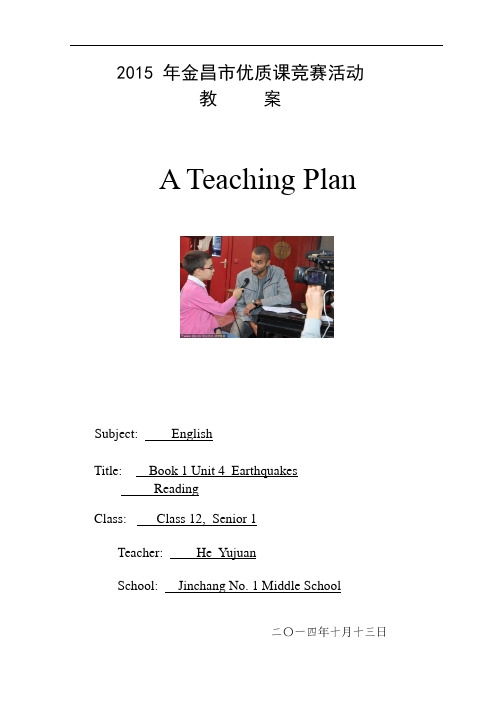
2015 年金昌市优质课竞赛活动教案A Teaching PlanSubject: EnglishTitle: Book 1 Unit 4 EarthquakesReadingClass: Class 12, Senior 1Teacher: He YujuanSchool: Jinchang No. 1 Middle School二〇一四年十月十三日A Teaching PlanTitle: Book1 Unit 4 Earthquakes --- ReadingTarget students: Class 12, Senior 1Teacher: Wang YaqinAnalysis of the teaching materialsThis period we will deal with Reading in Book 1 Unit 4 Earthquakes. The topic of the unit is "eathquake", which involves signs before the earthquake、during the earthquake and after the earthquake. Our language knowledge and skills are designed on the basis of the topic"earthquake", the purpose of which is mainly to improve students ' abilities of reading. Intentions of our designsThe new curriculum standards are the base and guide to teaching, which require us , on the basis of textbooks and extra teaching resources, to effectively combine teachers’conducting and explaining with students’independent research and cooperative learning, solve “double bases” (language knowledge and abilities), develop students’ skills (obtain information, discover, analyze and solve problems) and fulfill moral education, thus achieving the aim of efficient learning- enjoying learning, being good at learning and being able to use it. As far as I’m concerned, teachers and students will research effectively, combine resources and achieve 3D aims. Based on the analysis of the key points and the contents of the teaching materials, the general clue of of our design is focused on three questions, "what happened before the earthquake?" 、"what happened during earthquake ?" "what happened after the earthquake ?" Therefore, we will conduct a series of classroom activities such as pair work, group work, question and answer ,of which how to motivate students to participate actively and learn to cooperate in team work is very important. Anyway, the principle of student-centred and practice-going-first will be reasonably carried out when my design is properly performed, which is originally the basic standards the new curriculum and the new textbooks.Teaching aims---3D GoalsKnowledge aims:1. Enable the students to recognize the variety of jobs there are in newspapers and what is needed to work in a newspaper office.2. Enable the students to recognize the variety of jobs there are in newspapers and what is needed to work in a newspaper office.Ability aims:1. To train and improve students’ ability to learn words and phrases by brainstorming.2. To improve students’ ability to express their own ideas by asking and answering questions. Emotional aims:1. To make the students understand the job of journalists better.2. To develop their interest in interviewing and in their own studies.Key and important points :1.Help students to know the jobs of journalists and the qualities they need.2.How to help students to learn to conduct an interview in English.Teaching methods:Task-based approach &. Communicative teaching methodBlackboard design:学情分析及前期预测:现在的学生,英语水平总体差距较大,其水平分布呈以下特点:分化情况较明显,学生之间的水平差距较大;学生虽然对英语感兴趣,但学习主动性还有待加强;部分学生对教师的依懒性较强,未能主动通过多种渠道获取信息。
初中earthquake教案

初中earthquake教案课程目标:1. 让学生了解地震的基本知识,知道地震是如何发生的。
2. 让学生学会在地震发生时如何保护自己,避免受到伤害。
3. 让学生了解地震后的应对措施,知道如何进行自救和互救。
教学重点:1. 地震的基本知识2. 地震时的自我保护措施3. 地震后的应对措施教学难点:1. 地震时的自我保护措施2. 地震后的应对措施教学准备:1. 课件:地震知识、地震时的自我保护、地震后的应对措施2. 视频:地震发生时的场景教学过程:一、导入(5分钟)1. 引导学生关注地震新闻,了解地震对人类生活造成的影响。
2. 提问:同学们,你们知道地震是什么吗?地震是如何发生的?二、地震知识讲解(10分钟)1. 讲解地震的基本知识,包括地震的成因、地震的等级、地震的特点等。
2. 讲解地震发生时的现象,如地面的震动、房屋的倒塌等。
三、地震时的自我保护(10分钟)1. 讲解在地震发生时如何保护自己,如躲到桌子下面、远离玻璃窗等。
2. 讲解在地震发生时不要乘坐电梯、不要靠近高大建筑物等。
3. 进行地震逃生演练,让学生熟悉地震逃生的路线和步骤。
四、地震后的应对(10分钟)1. 讲解地震后的应对措施,如寻找安全的地方避难、等待救援等。
2. 讲解在地震后如何进行自救和互救,如止血、救治受伤人员等。
五、总结与反思(5分钟)1. 让学生总结地震时的自我保护措施,加深记忆。
2. 让学生思考如何在地震后进行自救和互救,提高应对能力。
教学评价:1. 学生对地震知识的掌握程度。
2. 学生对地震时的自我保护措施的熟悉程度。
3. 学生对地震后的应对措施的了解程度。
教学反思:本节课通过讲解和演练,让学生了解了地震的基本知识,学会了在地震发生时如何保护自己,知道了地震后的应对措施。
但在教学过程中,发现部分学生对地震知识的掌握程度不高,需要在今后的教学中加强。
同时,地震逃生演练的次数可以适当增加,提高学生的应对能力。
高中英语-Unit4Earthquake教学设计学情分析教材分析课后反思全文编辑修改
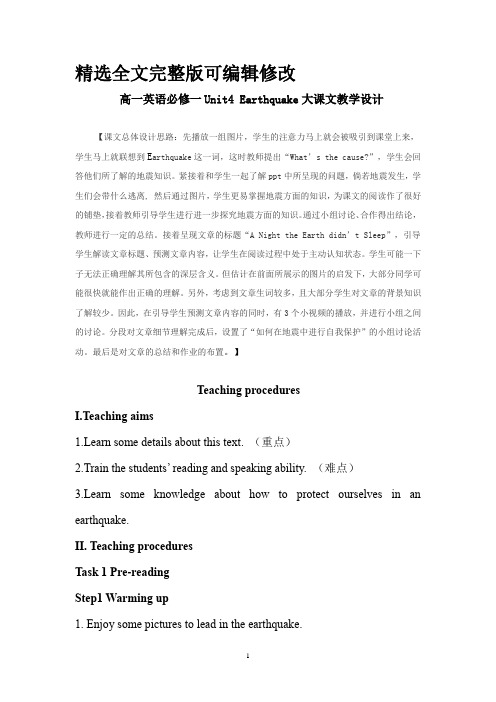
精选全文完整版可编辑修改高一英语必修一Unit4 Earthquake大课文教学设计【课文总体设计思路:先播放一组图片,学生的注意力马上就会被吸引到课堂上来,学生马上就联想到E arthquake这一词,这时教师提出“What’s the cause?”,学生会回答他们所了解的地震知识。
紧接着和学生一起了解ppt中所呈现的问题,倘若地震发生,学生们会带什么逃离, 然后通过图片,学生更易掌握地震方面的知识,为课文的阅读作了很好的铺垫,接着教师引导学生进行进一步探究地震方面的知识。
通过小组讨论、合作得出结论,教师进行一定的总结。
接着呈现文章的标题“A Night the Earth didn’t Sleep”,引导学生解读文章标题、预测文章内容,让学生在阅读过程中处于主动认知状态。
学生可能一下子无法正确理解其所包含的深层含义。
但估计在前面所展示的图片的启发下,大部分同学可能很快就能作出正确的理解。
另外,考虑到文章生词较多,且大部分学生对文章的背景知识了解较少。
因此,在引导学生预测文章内容的同时,有3个小视频的播放,并进行小组之间的讨论。
分段对文章细节理解完成后,设置了“如何在地震中进行自我保护”的小组讨论活动。
最后是对文章的总结和作业的布置。
】Teaching proceduresI.Teaching aims1.Learn some details about this text. (重点)2.Train the students’ reading and speaking ability. (难点)3.Learn some knowledge about how to protect ourselves in an earthquake.II. Teaching proceduresTask 1 Pre-readingStep1 Warming up1. Enjoy some pictures to lead in the earthquake.Step2 Brainstorming1.Imagine your home begins to shake and you must leave it right away.You have time to take only one thing. What will you take?I will takeTask 2 While-readingStep1 Fast reading : True or False.1.The passage mainly talks about a/an ___________(what) thathappened in _________ (where)in ______(when).2.Please divide the passage into 3 parts according to the main idea.Look at the each part and write down its main idea.Part 1: main idea:Part 2: main idea:Part 3: main idea:Step2 Careful reading1. What are the strange things before the earthquake? Read part.1 carefully and fill in the blanks.①The water in the wells____and____. And some deep ____could be seen in the well walls. A ____gas came out the cracks.②The chickens and even pigs were______nervous _____eat.③Mice ran out of the fields_____places to hide.Fish ______out of bows and ponds.④People could see ___lights in the sky. The sound of _____could beheard outside the city.The water pipes in some buildings____and_____. 2.Read part 2 and finish the exercises.②True ( T )or False( F )1.Two-thirds of the nation felt the earthquake. ( )2. All the people in Tangshan were dead or injured during the earthquake. ( )3. All of the city’s hospitals, factories, buildings and homes were damaged in the earthquake. ( )4. Not only the people but also the animals were shocked greatly.( )5. Many rescue workers and doctors were trapped under the ruins during the aftershock. ( )3.Soon after the quakesThe army:Workers:Result:nguage points1.. … the water pipes in some buildings cracked and burst.burst :(vt.vi.n)突然破裂,爆发.burst into+ n. burst out + doing……He burst into laughter.= .2. It seemed as if the world was at an end.1) as if①as if 在表语从句中相当于that:②as if 似乎, 好像= as thoughShe spoke to me as if she knew me.③as if后还可跟名词、形容词、不定式等。
最新-Earthquakes教案优秀3篇
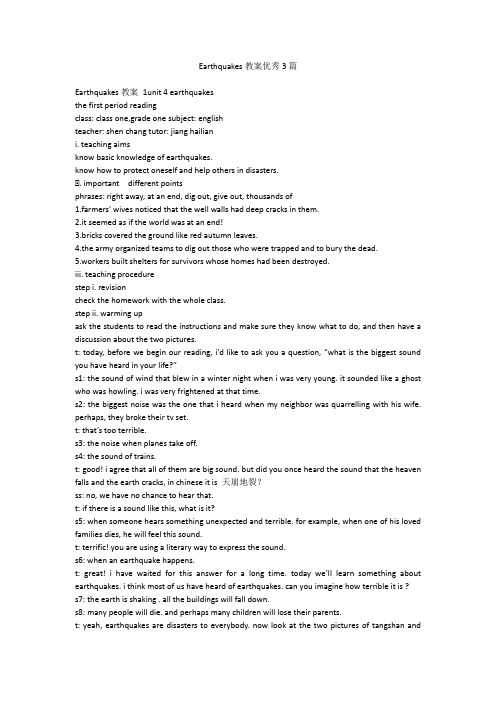
Earthquakes教案优秀3篇Earthquakes教案1unit 4 earthquakesthe first period readingclass: class one,grade one subject: englishteacher: shen chang tutor: jiang hailiani. teaching aimsknow basic knowledge of earthquakes.know how to protect oneself and help others in disasters.ⅱ. important different pointsphrases: right away, at an end, dig out, give out, thousands of1.farmers’ wives noticed that the well walls had deep cracks in them.2.it seemed as if the world was at an end!3.bricks covered the ground like red autumn leaves.4.the army organized teams to dig out those who were trapped and to bury the dead.5.workers built shelters for survivors whose homes had been destroyed.iii. teaching procedurestep i. revisioncheck the homework with the whole class.step ii. warming upask the students to read the instructions and make sure they know what to do, and then have a discussion about the two pictures.t: today, before we begin our reading, i’d like to ask you a question, “what is the biggest sound you have heard in your life?”s1: the sound of wind that blew in a winter night when i was very young. it sounded like a ghost who was howling. i was very frightened at that time.s2: the biggest noise was the one that i heard when my neighbor was quarrelling with his wife. perhaps, they broke their tv set.t: that’s too terrible.s3: the noise when planes take off.s4: the sound of trains.t: good! i agree that all of them are big sound. but did you once heard the sound that the heaven falls and the earth cracks, in chinese it is 天崩地裂?ss: no, we have no chance to hear that.t: if there is a sound like this, what is it?s5: when someone hears something unexpected and terrible. for example, when one of his loved families dies, he will feel this sound.t: terrific! you are using a literary way to express the sound.s6: when an earthquake happens.t: great! i have waited for this answer for a long time. today we’ll learn something about earthquakes. i think most of us have heard of earthquakes. can you imagine how terrible it is ?s7: the earth is shaking . all the buildings will fall down.s8: many people will die. and perhaps many children will lose their parents.t: yeah, earthquakes are disasters to everybody. now look at the two pictures of tangshan andsan francisco. can you describe what you see in the pictures?s1: tangshan is a beautiful city. it has beautiful gardens, broad roads and some tall buildings.s2: from the picture of san francisco, i can see that it is a very big city. there are many tall buildings thickly standing on the earth. i think the population of the city is very large.t: good! what will happen if there has been a big earthquake in these two cities? work in pairs and discuss it. then i’ll ask so me of you to show your opinion.step iii. pre-readingthere are two questions in this part. both are very interesting. the first one can more or less reveal the students’ values; while the second one can enlarge their imagination. no matter what their answers are, as long as they have given careful thoughts to the situations, their answers should be good.t: now, let’s look at the pictures. what are the predictions of an earthquake?s1: before an earthquake animals will become nervous. cows, pigs, horses and dogs will be upset. and people can see mice running about. if the earthquake happens during winter, people can even see snakes.t: terrific! where did you get this knowledge?s1: from geography. i like it.t: good. sit down please.s2: madam, i don’t know the meaning of the picture with two women.t: it doesn’t matter. you will know it soon after reading our text. ok. imagine there is an earthquake now, and your home is shaking, at this moment you have no time to take any other things but one, what will it be?s3: i’ll take all my money. people can’t live without money.s4: i will take as much water as possible. because it is said that people can keep alive for nearly 7 days by drinking without any foods5: in that case, i’d rather take some apples, so that besides drinking, i can also eat.s6: i will carry my grandma. she is my most loved person in this world. she brought me up.t: what a dutiful child you are! i’m very glad to hear that. sit down please! it seems that all of you know what you should do during an earthquake. ok. let’s read our text, and see what it tells us. step iv. readingin this part, teacher should ask the students to read the passage quickly for the first time to get the general idea of the passage. ask them to pay attention to the first sentence of each paragraph. this can help them finish exercise3 in comprehension. it is about the main idea of each paragraph. then ask them to read the text again carefully to obtain some details. before reading for the second time, show some questions on the screen, and let the students read the questions first. these questions can guide them to have a good understanding about the text. they can also make preparations for exs1-2, which are about details.skimmingt: at first i’d like to read the text quickly to get the general idea of the article. while reading, you should pay attention to the sentence of each paragraph.t: have you got the general idea of the text?ss: yes.t: what is it?s1: there is no quick answer to this question. are you suggesting us that the general idea is themixture of the first sentences of each paragraph?t: sure.s1:ok. that’s easy. the main idea of the passage is some signs of the earthquake, and what would happen during the quake.t: good, sit down please. in fact, while we are answering the questions, we have involved the sequence, the functional item for this unit. (teacher writes the word on the blackboard) do you understand the meaning of the word?ss: no.t: sequence means the order of the events. it can tell us which event happens first, and which happens later. do you know the sequence that is used in our text?s3: yes. at first, the text tells us something that happened before the quake, then it tells us the things that happened during the quake and at last it tells us the things that happened after the earthquake.t: quite right! now please look at the screen, these are the first sentences of each paragraph. read them and think if they are the main idea of the text. if necessary, you may make some changes to make more exact.teacher shows the screen and gives a little time to think it over.1.strange things were happening in the countryside in the northeast hebei.2.the disaster happened and caused a lot of loss.3. all hope was not lost.careful readingt: now, it’s time for us to read the text carefully. but before reading, you should read some questions first. these questions may help you get some information quickly and easily. now look at the screen, and read the questions.show on the screen1.what natural signs of a coming disaster were there?2.can you think of some reasons why these signs weren’t noticed?3.what events probably made the disaster worse?4.what situations probably made the disaster worse?5.how were the survivors held?step v. extensionshow the questions on the screen.1.from whose point of view are events described? how do you know?2.what is the mood of this passage? how is it created?3.why do you think the writer chooses to express his feelings about the quake rather than simply reporting what had happened?4.why is the title a night the earth didn’t sleep?5.what does the sentence “slowly, the city began to breathe again.” mean?answers:1.he uses third-person to describe the quake. his description is very objective. for example, the second sentence in the third paragraph. the writer says: “everywhere they looked nearly everything was destroyed.” the writer uses they instead of we.2.the mood is serious and a bit sad. it is created by giving details of how many people and animals were killed or injured, and how many buildings were destroyed.3.although the writer was not there, he felt sad for the people of tangshan. he knows that some personal feelings will make the reading more interesting.4.i think the reason is that, as usual, night is the time to sleep, and night should be safe and quiet. but that night everything changed. the writer uses a night the earth didn’t sleep as a title to show how terrible and how unusual the night was.5.here we can see that the writer compared the city to a person who suffered a lot in the disaster. he felt her pain, and he worried about her. so when he said that people came to help her, we can feel his feelings to the city. the city will not die, she has hope and she can recover from the pain. step vi comprehendinganswers to exx1-31.1. c2. e3.b4.d5.a2.1. the walls of the villages wells had cracks in them.2 .roads got huge cracks3. brick buildings were destroyed.4. the army helped the survivors.5. shelters were put up for those with no homes.3.1. strange things were happening in the countryside in northeast hebei..1.the disaster happened and caused a lot of loss.2.all hope was not lost.step vii homeworkEarthquakes教案2新课标高一必修1英语教案unit 4 earthquakes (简案)teaching plan for unit 4 earthquakesteaching aims and demands:1. topic:basic knowledge of earthquakes; how to protect oneself and help the others in disasters2. useful words and expressions:shake, well (n.), rise, smelly, pond, pipe, burst, canal, steam, dirt, ruin, injure, destroy, brick, dam, useless, steel, shock, quake, rescue, electricity, disaster, army, organize, bury, coal, shelter, fresh, percent, speech, judge, honour, prepare;right away, (be) at an end, dig out, bring in, a (great )number of3. functions:talking about past experiences:i will never forget the day when the earthquake took place. the time was 5:15 in the afternoon and i was driving along the road.sequence4. grammar:the attributive clause (i)由that, which, who, whose引导的定语从句the number of people who were killed or injured reached more than 400,000.it was heard in beijing which is one hundred kilometers away.workers built shelters for survivors whose homes had been destroyed.teaching procedures:period 1.step 1. warming upss discuss and answer some questions:1. which of the following may cause people the greatest damage?a. earthquakeb. typhoonc. floodd. drought2. imagine your home begins to shake and you must leave it right away. you have time to take only one thing. what will you take? why?step 2. pre-readingss discuss and answer:1. do you know what would happen before an earthquake?2. what can we do to keep ourselves safe from an earthquake?3. do you know anything about tangshan earthquake in 1976?step 3. reading1. skimming and find the answers to the following questions:a. what happened?b. when and where did it happen?2. ss read again and fill in the following form:time what happenedbefore the earthquake wells:animals:lights and sound:water pipes:while the earthquake houses, roads and canals:hard hills of rock:the large city:the people:after the earthquake hospitals, factories and buildings:the ground:dams:railway tracks:animals:wells:3. ss read the whole passage again and get the main ideas of each part:part 1. the natural signs of a coming earthquakepart 2. the damage of the city after the earthquakepart 3. the help to the survivorsstep 4. comprehendingss finish ex 1 and 2 on page 27.step 5. assignment1. surf the internet and get more information about the earthquake.2. retell the text.period 2.step 1. warming up1. ss share more information about the earthquake.2. ask some ss to retell the text by using their own words.step 2. language points1. lie –lay-lain (v.) : to be, remain or be kept in a certain state 处于某种状态the village lay in ruins after the war.these machines have lain idle since the factory closed.2. in ruins: severely damaged or destroyed 毁坏an earthquake left the whole town in ruins.his career is in ruins.3. number (n.): a quantity of people or things 数目;数量the number of people applying has increased this year.we were fifteen in number.a number of: a lot ofi have a number of letters to write.a large number of people have applied.4. injure (v.): to hurt oneself/sb./ sth. physically 受伤he fell off the bicycle and injured his arm.5. reach (v.): to achieve or obtain sth. 达成;达到;获得you’ll understand it when you reach my age.at last we reached a decision.6. rescue (n.): an act of rescuing or being rescued 搭救;解救a rescue team is trying to reach the trapped mines.rescue (v.): to save or set free from harm, in danger, or loss 解救;救出the rescued the man from drowning.7. trap(v.): in a place from which one wants to escape but cannot 困住;陷于绝境they were trapped in the burning hotel.8. all …not… = not all…: some but not all 一些;但不是全部not all the girls left.=only some of them left early.not all the children are noisy.=some of the children are not noisy.全部否定应用:none of…none of us were allowed to go there.none of these reports is very helpful.step 3. learning about language1. ss finish ex 1,2 and 3 on page 27 and 28.2. teacher checks the answer and give the ss some help if they have some difficulty.step 4. assignment1. finish wb.ex.1 on page 63.2. ss try to remember the useful words and expressions by hearts.period 3step 1. warming upss read the passage again and try to find the sentences with attributive clauses.e.g. workers built shelters for survivors whose homes had been destroyed.step 2. attributive clause1. give ss more sentences and let the ss to find the structures of the attributive clause.2. ss do some exercises about how to use that, which, who or whose.3. ss finish ex 2 on page 28.some materials about attributive clause:关系代词引导的定语从句关系代词所代替的先行词是人或物的名词或代词,并在句中充当主语、宾语、定语等成分。
【高一英语】必修1《Unit4 Earthquake 》优质课教案
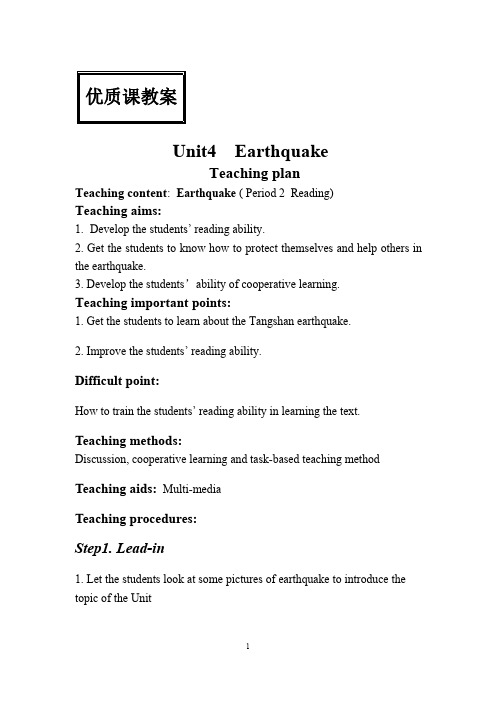
优质课教案Unit4EarthquakeTeaching planTeaching content:Earthquake(Period2Reading)Teaching aims:1.Develop the students’reading ability.2.Get the students to know how to protect themselves and help others in the earthquake.3.Develop the students’ability of cooperative learning. Teaching important points:1.Get the students to learn about the Tangshan earthquake.2.Improve the students’reading ability.Difficult point:How to train the students’reading ability in learning the text. Teaching methods:Discussion,cooperative learning and task-based teaching method Teaching aids:Multi-mediaTeaching procedures:Step1.Lead-in1.Let the students look at some pictures of earthquake to introduce the topic of the Unit2.Let the students enjoy a part of film of earthquake and get the studentsto answer the questions.⑴What happened in the film?⑵What are the people doing?3.Get the students to discuss the following question:(分组讨论)What do you think will happen before an earthquake? Step2.Fast reading(1)Let the students skim the text and divide the text into three parts.(2)Let the students find the top sentence of each paragraph and summarize the main idea of each partMain idea of each part:Part1(para.1):Strange things were happening before the earthquake.Part2(para.2-3):The disaster happened and caused a lot of loss. Part3(para.4):All hope was not lost.(Exchange your understanding of the passage with group members and work together to find the main idea of each part.培养学生归纳概括能力)Step3.Careful reading1.Read carefully and try to get more information to fill in the blanks.Strange thingsthe water in the village wells rose and fellthe well walls had deep cracks and smelly gascame outthe chickens and pigs were too nervous to eatmice ran out of the fields,looking forplaces to hidefish jumped out of the bowls andponds(用表格的形式表达出来,以锻炼学生的主学习能力和探究查读能力,使学生全面地了解地震的前兆。
高一英语必修一Unit-4-earthquakes的阅读公开课课教案

Unit 4 EartquakesYuan XiaoshaTitle: Book1 Unit 4 Earthquakes --- ReadingTarget students: Senior 1Teacher: Yuan XiaoshaTeaching aimsKnowledge aims:1. Enable the students to memorize useful expressions.2. Enable the students to know what to do in an earthquake..Ability aims:1. To train and improve students’ ability to read a passage.2. To improve students’ability to express their own ideas by asking and answering questions.Emotional aims:1. To make the students never lost hope in daily life.2. To develop their habit in helping others.Key and important points :eful expressions(injury, in ruins…)2.How to help students to improve reading skills.Teaching methods:Task-based approach &. Communicative teaching method学情分析及前期预测:高一学生,刚军训完一个月,英语水平总体差距较大,其水平分布呈以下特点:分化情况较明显,学生之间的水平差距较大;学生虽然对英语感兴趣,但学习主动性还有待加强;部分学生对教师的依懒性较强,未能主动通过多种渠道获取信息。
unit4Earthquake全单元教案
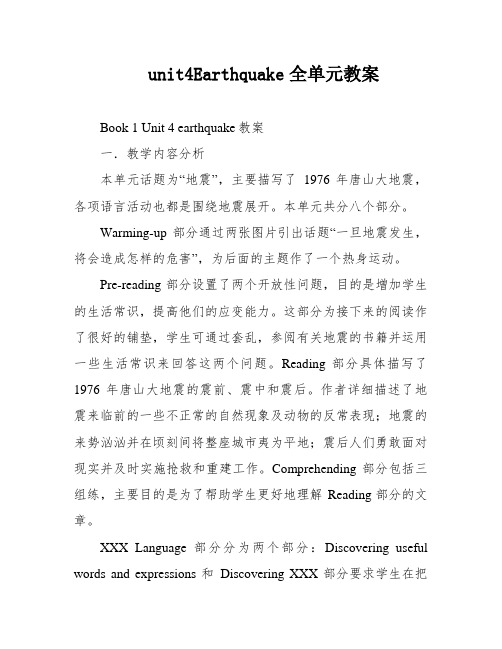
unit4Earthquake全单元教案Book 1 Unit 4 earthquake教案一.教学内容分析本单元话题为“地震”,主要描写了1976年唐山大地震,各项语言活动也都是围绕地震展开。
本单元共分八个部分。
Warming-up部分通过两张图片引出话题“一旦地震发生,将会造成怎样的危害”,为后面的主题作了一个热身运动。
Pre-reading部分设置了两个开放性问题,目的是增加学生的生活常识,提高他们的应变能力。
这部分为接下来的阅读作了很好的铺垫,学生可通过套乱,参阅有关地震的书籍并运用一些生活常识来回答这两个问题。
Reading部分具体描写了1976年唐山大地震的震前、震中和震后。
作者详细描述了地震来临前的一些不正常的自然现象及动物的反常表现;地震的来势汹汹并在顷刻间将整座城市夷为平地;震后人们勇敢面对现实并及时实施抢救和重建工作。
Comprehending部分包括三组练,主要目的是为了帮助学生更好地理解Reading部分的文章。
XXX Language部分分为两个部分:Discovering useful words and expressions和Discovering XXX部分要求学生在把握文章的基础上,掌握重点词汇的词义及时用,这更注重培养学生运用上下文猜测词义的能力。
其次还对一些复杂的数字读法进行了检测。
第二部分则结合文章研究定语从句。
Using Language局部分为Reading,Writing and Speaking;Listening和Writing。
Reading,XXX包孕读一篇约请函,写一份演讲稿和关于一套新唐山邮票的XXX局部报告了一名地动幸存者的故事,并按照听力材料举行正误判别和回覆下列题目,旨在造就学生获得细节的本领,并经由过程听来仿照尺度的语音和腔调。
Writing局部请肄业生报纸写一篇消息报导,进修若何依照尺度的步调举行写作,如挑选得本地题目和构造言语等。
【高一英语】必修1《Unit4 Earthquake 》优质课教案

优质课教案Unit4EarthquakeTeaching planTeaching content:Earthquake(Period2Reading)Teaching aims:1.Develop the students’reading ability.2.Get the students to know how to protect themselves and help others in the earthquake.3.Develop the students’ability of cooperative learning. Teaching important points:1.Get the students to learn about the Tangshan earthquake.2.Improve the students’reading ability.Difficult point:How to train the students’reading ability in learning the text. Teaching methods:Discussion,cooperative learning and task-based teaching method Teaching aids:Multi-mediaTeaching procedures:Step1.Lead-in1.Let the students look at some pictures of earthquake to introduce the topic of the Unit2.Let the students enjoy a part of film of earthquake and get the studentsto answer the questions.⑴What happened in the film?⑵What are the people doing?3.Get the students to discuss the following question:(分组讨论)What do you think will happen before an earthquake? Step2.Fast reading(1)Let the students skim the text and divide the text into three parts.(2)Let the students find the top sentence of each paragraph and summarize the main idea of each partMain idea of each part:Part1(para.1):Strange things were happening before the earthquake.Part2(para.2-3):The disaster happened and caused a lot of loss. Part3(para.4):All hope was not lost.(Exchange your understanding of the passage with group members and work together to find the main idea of each part.培养学生归纳概括能力)Step3.Careful reading1.Read carefully and try to get more information to fill in the blanks.Strange thingsthe water in the village wells rose and fellthe well walls had deep cracks and smelly gascame outthe chickens and pigs were too nervous to eatmice ran out of the fields,looking forplaces to hidefish jumped out of the bowls andponds(用表格的形式表达出来,以锻炼学生的主学习能力和探究查读能力,使学生全面地了解地震的前兆。
earthquake公开课课件

,a click to unlimited possibilities
汇报人:
目录
CONTENTS
01 添加目录标题 02 课件概览 03 地震基础知识 04 地震预警与救援 05 地震防范与减灾
06 地震科学研究
单击添加章节标题
第一章课件概览第二章Fra bibliotek课件封面
标题: earthquake 公开课课件
火山地震:由于火 山岩浆活动、气体 爆炸等引起的地震
塌陷地震:火山岩 浆活动或地下岩洞 崩塌引起的地震
人工地震:由于地 下核爆炸、大规模 爆炸等人为活动引 起的地面振动
地震波
地震波的分类:分为体波和面波,体波又分为P波和S波,面波分为L波 地震波传播方式:地震波传播有折射、反射、绕射等现象 地震波传播速度:在不同介质中传播速度不同,通常在固体中传播速度最快 地震波对地表的影响:地震波对地表造成破坏,产生地表破裂、喷砂、冒水等现象
混凝土等
建筑布局:合 理规划建筑物 的布局,避免 建筑物之间相
互影响
建筑细节:加 强建筑物的细 节设计,如增 加抗震缝、加 强建筑物的支
撑结构等
家庭防震措施
制定家庭防震计划 准备必要的防震物品 确定安全的避难场所 学习正确的避险姿势和自救互救方法
学校、社区防震准备
制定应急预案:学校和社区应制定地震应急预案,明确应急组织、通讯联络、疏散路线、紧 急避难场所等。
副标题:地震 科普知识
作者:XXX
封面图片:一 张与地震相关 的图片,如地 震后的场景或 地震预警图标
等
课件目录
课件封面 课程介绍 地震基本知识 地震预警与避险 地震救援与重建 课程总结
马秀玲Earthquake教学设计新部编版
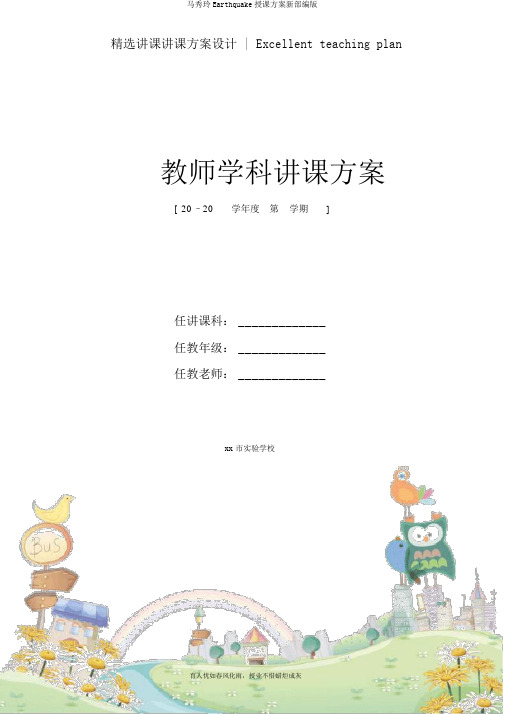
精选讲课讲课方案设计 | Excellent teaching plan教师学科讲课方案[ 20–20学年度第__学期]任讲课科: _____________任教年级: _____________任教老师: _____________xx市实验学校Earthquake 讲课方案云南省富源县第一中学马秀玲讲课目标1. Knowledge①Vocabulary :survivor, brick, useless, shock, quake, rescue, shake, rise, crack, burst, well, smelly, pond, steam, destroy, ruin, injure, electricity, disaster, organize, fresh, percent, honor, prepare.② Phrases and expressions:wake sb up, prepare sth for sth, betrapped under sth, to the north of sp, put up, give out, right away.③Grammar: The Attributive Clause 并明确描述任务的特色、行为时who/ whom/ whose/ that指引;描述事物、事件的性质、内容时由which/ that/ whose 指引。
2. Ability① 培育学生运用所学语言知识描述地震先兆、危害及震后援救的能力;② 提升学生依据已知信息推测将要听取的资料的内容,并进行思想、推理、判断的能力③ 掌握朗读中连读和略读的技术。
明确并识记演讲稿的格式及新闻报导的写作步骤。
3. Attitude and emotion① 认识掌握地震方面的知识,包含地震的形成原由、地震时的应急逃生、地震后如何科学救人及减少地震所造成的损失等知识;② 地震无情人有情,明确无论发生了多么可怕的灾害,国家和解放军官兵都会无论自己安危,奋力急救,培育学生一方有难、八方增援的互助友善精神;③ 培育学生的合作意识和“合作学习”的习惯,在赏识课文中优美句子的同时学习英语修辞手法,最后获得美的享受和心灵的升华。
《Unit 4 Earthquakes》教学设计
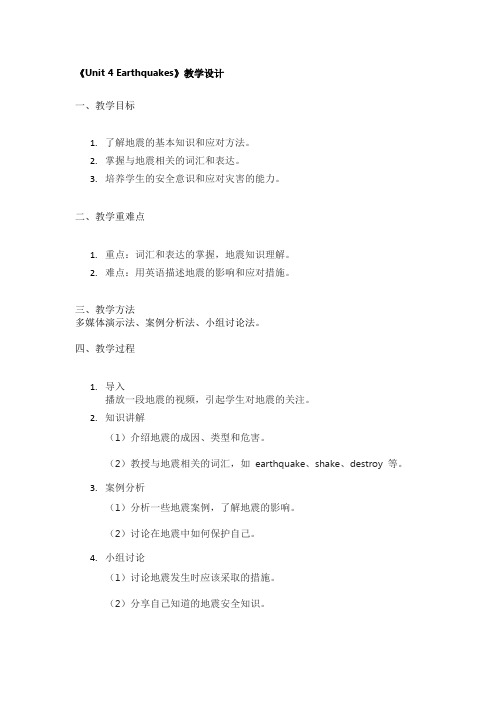
《Unit4Earthquakes》教学设计
一、教学目标
1.了解地震的基本知识和应对方法。
2.掌握与地震相关的词汇和表达。
3.培养学生的安全意识和应对灾害的能力。
二、教学重难点
1.重点:词汇和表达的掌握,地震知识理解。
2.难点:用英语描述地震的影响和应对措施。
三、教学方法
多媒体演示法、案例分析法、小组讨论法。
四、教学过程
1.导入
播放一段地震的视频,引起学生对地震的关注。
2.知识讲解
(1)介绍地震的成因、类型和危害。
(2)教授与地震相关的词汇,如earthquake、shake、destroy等。
3.案例分析
(1)分析一些地震案例,了解地震的影响。
(2)讨论在地震中如何保护自己。
4.小组讨论
(1)讨论地震发生时应该采取的措施。
(2)分享自己知道的地震安全知识。
5.课堂小结
总结地震的知识和应对方法,以及相关词汇。
6.作业布置
(1)制作一份地震应急手册,用英语介绍。
(2)写一篇关于地震的短文,描述地震的危害和应对措施。
Unit 4 Earthquakes 公开课 教案

人教版必修一Unit 4 EarthquakesA Night the Earth Didn’t Sleep 阅读课教学设计北京顺义一中李晓娅2018/10/11主题语境:唐山大地震语篇类型:叙述类文章授课时长:两课时(本课为第一课时)文本分析:课文主要讲述了1976年7月28日凌晨发生在河北省东北部唐山市的大地震,通过对震前征兆、地震发生和震后救援的具体描述,向我们再现了唐山大地震这场二十世纪人类遭受的最惨重的自然灾害。
文章主要通过时间顺序和事件的发展顺序展开。
重点词汇涉及到地震的一些动词,并让学生体会随着时间的推移、事情的发展,人们的心情变化,做到感同身受。
通过学习,学生能够了解更多关于地震的常识,对地震前的预兆有意识,面对突然来临的自然灾难,能够从容镇定,积极勇敢地面对。
学情分析:学生为国际学校高一新生,入学一个月,仍然处于初高中衔接适应阶段,一些学生具备从文章中获取信息的能力,但是多数学生阅读技巧有待培养,在理解和整合知识、逻辑推理等方面能力比较欠缺。
此外,学生对地震的相关知识比较陌生,对唐山大地震震前征兆、地震发生和震后救援缺乏深层理解。
教学目标:在本课学习结束时,学生能够:1.获取梳理文中有关震前征兆、地震发生和震后救援的事实性信息;2.推断体会随着时间推移和事件的发展人们心情的变化并对文本进行分析和深度解读。
3.体会本课所体现的一方有难八方支援的精神并积极面对困难。
教学重点:学生运用一定的阅读策略,获取有关震前、震中和震后的事实信息。
教学难点:通过梳理和整合所读的文章信息,对文本进行分析和深度解读。
教学资源:教材、多媒体课件、学案、黑板和粉笔教学过程:。
公开课教案Unit4 Earthquake

Unit4 EarthquakeGrammar-Attributive Clause (that、which、who、whose)整体教学理念:寓学于乐语法教学理念:“三维语法教学”-新课程标准明确指出:基础教育阶段英语课程目标是以学生语言知识、语言技能、学习策略、情感态度、文化意识的发展为基础,培养学生综合语言运用能力。
“三维语法教学”以新课程英语目标为宗旨,倡导语法教学中既注重语法的形式(from)和意义(meaning),也注重语法的实际运用(use)。
课题:人教版高中英语必修一Unit4 Earthquake课型:语法课(Attributive Clause:that、which、who、whose)课时:40mins学情分析:该班级学生英语普遍处于中等偏下水平,故教学过程中侧重语法的“form”和“meaning”,但同时也略微兼顾语法的“use’”。
教学目标:1.语言知识和语言技能目标:帮助学生初步了解、熟悉、理解定语从句相关概念(定语从句、定语从句的位置、先行词、关系代词、关系代词的作用);帮助学生理解、识记定语从句的基本常用句型;帮助学生掌握关系代指物时that和which的用法区别、关系代词指人时that和who的用法区别、关系代词在从句中作主语时主谓一致规律。
2.学习策略目标:引导学生学会从语言现象中总结归纳语法规律3. 情感态度以及文化意识目标:通过多次接触歌曲帮助学生树立使用语言的意识;进一步帮学生树立团队合作精神(课堂活动多以小组形式为主)教学重点:帮助学生掌握关系代指物时that和which的用法区别、关系代词指人时that和who 的用法区别、关系代词在从句中作主语时主谓一致规律。
教学难点:帮助学生树立使用语言的意识教学步骤:。
高一英语第四单元Earthquake教学案例
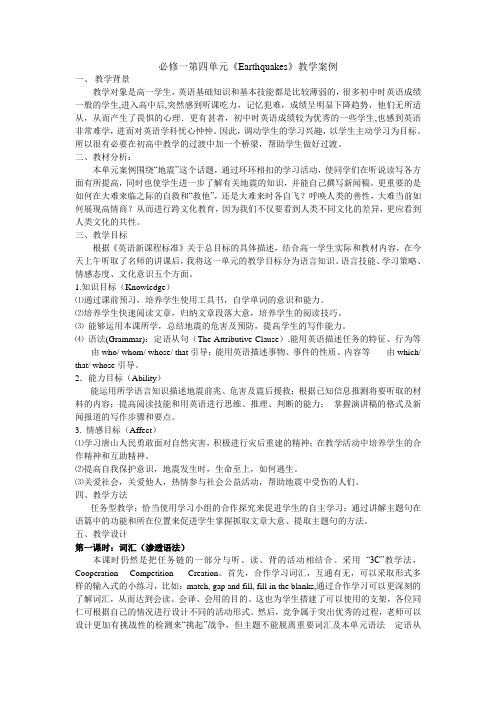
必修一第四单元《Earthquakes》教学案例一、教学背景教学对象是高一学生,英语基础知识和基本技能都是比较薄弱的,很多初中时英语成绩一般的学生,进入高中后,突然感到听课吃力,记忆犯难,成绩呈明显下降趋势,他们无所适从,从而产生了畏惧的心理.更有甚者,初中时英语成绩较为优秀的一些学生,也感到英语非常难学,进而对英语学科忧心忡忡。
因此,调动学生的学习兴趣,以学生主动学习为目标。
所以很有必要在初高中教学的过渡中加一个桥梁,帮助学生做好过渡。
二、教材分析:本单元案例围绕“地震”这个话题,通过环环相扣的学习活动,使同学们在听说读写各方面有所提高,同时也使学生进一步了解有关地震的知识,并能自己撰写新闻稿。
更重要的是如何在大难来临之际的自救和“救他”,还是大难来时各自飞?呼唤人类的善性,大难当前如何展现高情商?从而进行跨文化教育,因为我们不仅要看到人类不同文化的差异,更应看到人类文化的共性。
三、教学目标根据《英语新课程标准》关于总目标的具体描述,结合高一学生实际和教材内容,在今天上午听取了名师的讲课后,我将这一单元的教学目标分为语言知识、语言技能、学习策略、情感态度、文化意识五个方面。
1.知识目标(Knowledge)⑴通过课前预习,培养学生使用工具书,自学单词的意识和能力。
⑵培养学生快速阅读文章,归纳文章段落大意,培养学生的阅读技巧。
⑶能够运用本课所学,总结地震的危害及预防,提高学生的写作能力。
⑷语法(Grammar):定语从句(The Attributive Clause).能用英语描述任务的特征、行为等---- 由who/ whom/ whose/ that引导;能用英语描述事物、事件的性质、内容等---- 由which/ that/ whose引导。
2.能力目标(Ability)能运用所学语言知识描述地震前兆、危害及震后援救;根据已知信息推测将要听取的材料的内容;提高阅读技能和用英语进行思维、推理、判断的能力;掌握演讲稿的格式及新闻报道的写作步骤和要点。
高中英语地震试讲教案模板
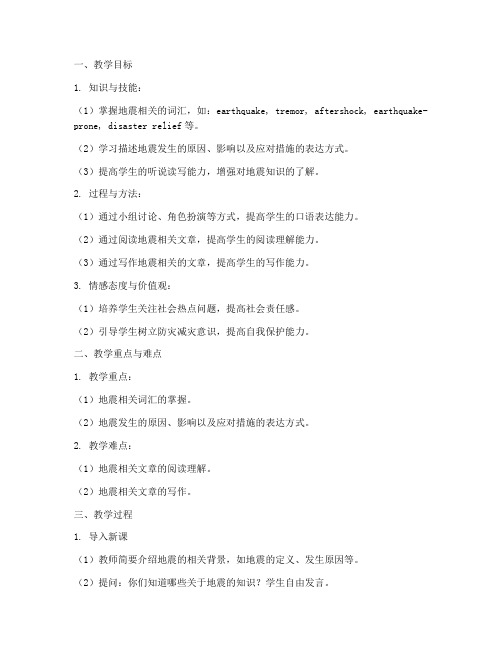
一、教学目标1. 知识与技能:(1)掌握地震相关的词汇,如:earthquake, tremor, aftershock, earthquake-prone, disaster relief等。
(2)学习描述地震发生的原因、影响以及应对措施的表达方式。
(3)提高学生的听说读写能力,增强对地震知识的了解。
2. 过程与方法:(1)通过小组讨论、角色扮演等方式,提高学生的口语表达能力。
(2)通过阅读地震相关文章,提高学生的阅读理解能力。
(3)通过写作地震相关的文章,提高学生的写作能力。
3. 情感态度与价值观:(1)培养学生关注社会热点问题,提高社会责任感。
(2)引导学生树立防灾减灾意识,提高自我保护能力。
二、教学重点与难点1. 教学重点:(1)地震相关词汇的掌握。
(2)地震发生的原因、影响以及应对措施的表达方式。
2. 教学难点:(1)地震相关文章的阅读理解。
(2)地震相关文章的写作。
三、教学过程1. 导入新课(1)教师简要介绍地震的相关背景,如地震的定义、发生原因等。
(2)提问:你们知道哪些关于地震的知识?学生自由发言。
2. 词汇学习(1)教师展示地震相关词汇,如:earthquake, tremor, aftershock, earthquake-prone, disaster relief等。
(2)学生跟读并模仿,加深对词汇的记忆。
3. 阅读理解(1)教师展示一篇关于地震的文章,学生分组阅读,并回答以下问题:a. 什么是地震?b. 地震发生的原因是什么?c. 地震有哪些影响?d. 如何应对地震?(2)小组讨论,分享阅读心得。
4. 口语表达(1)教师组织学生进行角色扮演,模拟地震发生时的情景,如:a. 学生扮演地震发生时的受害者,描述自己的感受。
b. 学生扮演救援人员,提供帮助。
(2)教师引导学生用所学词汇和句型进行表达,提高口语表达能力。
5. 写作训练(1)教师布置写作任务:以“地震逃生指南”为主题,写一篇短文。
- 1、下载文档前请自行甄别文档内容的完整性,平台不提供额外的编辑、内容补充、找答案等附加服务。
- 2、"仅部分预览"的文档,不可在线预览部分如存在完整性等问题,可反馈申请退款(可完整预览的文档不适用该条件!)。
- 3、如文档侵犯您的权益,请联系客服反馈,我们会尽快为您处理(人工客服工作时间:9:00-18:30)。
Teaching Plan for Earthquakes
(Listening and speaking)
Teaching content:
Module 1 Unit 4 workbook Listening and speaking
Three Dimensional Teaching Aims:
Knowledge Aims:
1.Get students to know what they should do in an earthquake.
2.Get students to know what they should prepare before an earthquake.
Ability Aims:
1.Enable students to master some listening skills.
2.Get students to express their opinions.
Emotional Aims:
1.Stimulate students’ spirit of helping each other when facing disasters.
2.Get students to know Love Can Make Wonders.
Teaching Importance:
1.Help students finish listening tasks using some listening skills.
2.Help students explain their reasons for the items that they choose for their
earthquake bags.
Teaching Difficulties:
1.Encourage students to speak out their opinions about the earthquake.
2.Encourage students to work together to choose items for their earthquake bag and
explain the reasons.
Teaching Methods:
Task-based teaching and situational teaching method
Learning Methods:
Cooperation and discovery
Teaching Aid:
Multi- media facilities
Teaching Procedures:
Step 1: Warming-up
Show a short video.
Question: What’s your feelings about the video ?
Step 2: Quiz(Yes or No)
What should we do in the earthquake?
Step3: Listening
Part1:
1.Write down 3 verbs that are mentioned twice.
2. T or F
1)We must drop to the floor and cover our heads with our hands.
2)We must cover ourselves by hiding under some furniture.
3)We must hold onto the furniture so it can move away from us during the earthquake.
Part2: Fill in the blanks
1.Go to an open space away from ________, _________ or _______ ______.
2.I should ______ the television to a _______ so it won’t move. I should make sure
the __________ are already ________ to the _________.
3.Ring a family member to tell them where I am and _________ my personal
_________ _______.
Step 4: Discussion
What will you put into your earthquake bags?
possible items for the personal earthquake bag:
bottle of water candles money knife map food and chocolate bars torch (手电筒)fruit clothes blanket medicine mobile phone pictures of family Step5: Speaking
My earthquake bag will contain:
1._________________________
2._____________________________
3._________________________
4._____________________________ Step6: Summary
Step7: Homework
Required(必做):Tell more people around you how to survive an earthquake.
Optional(选做):Find more information about people helping each other in an earthquake.。
